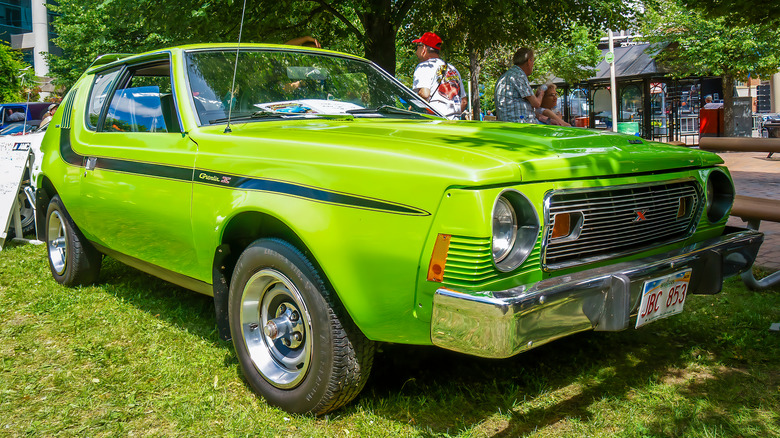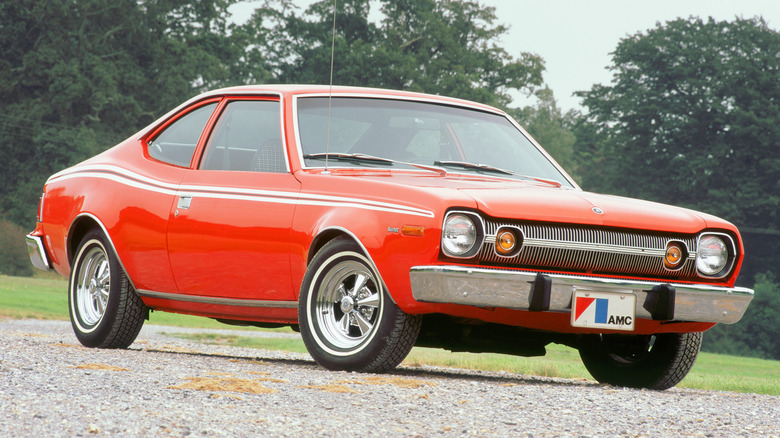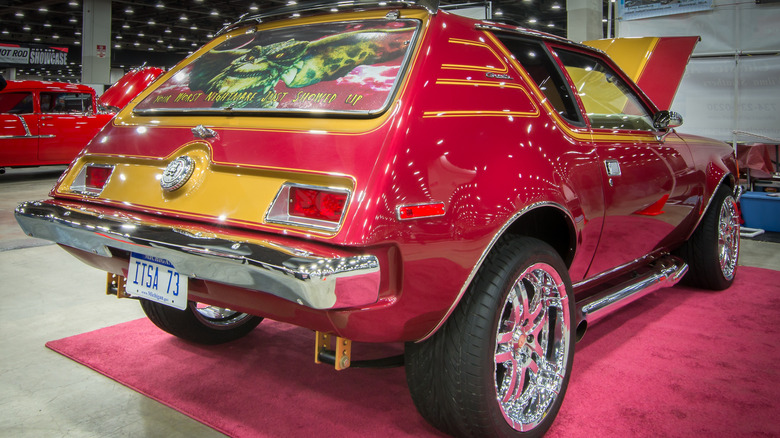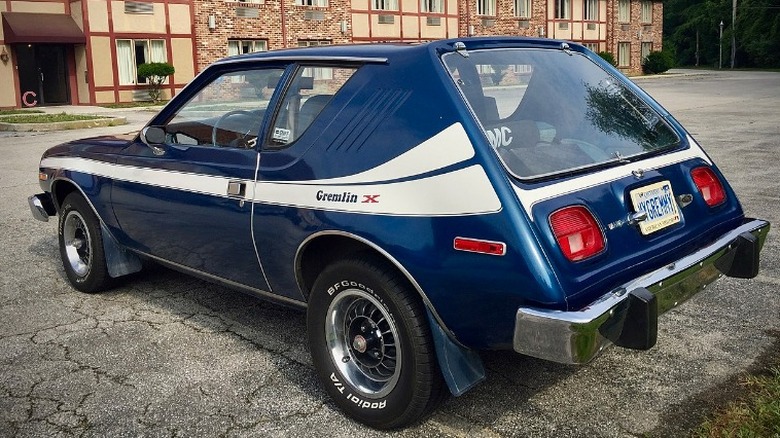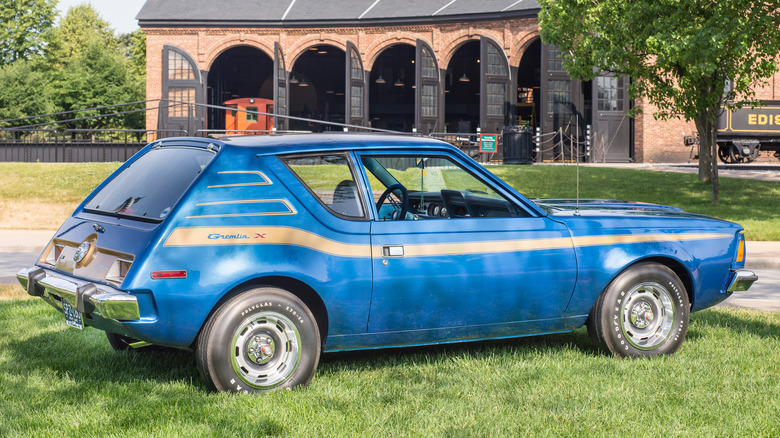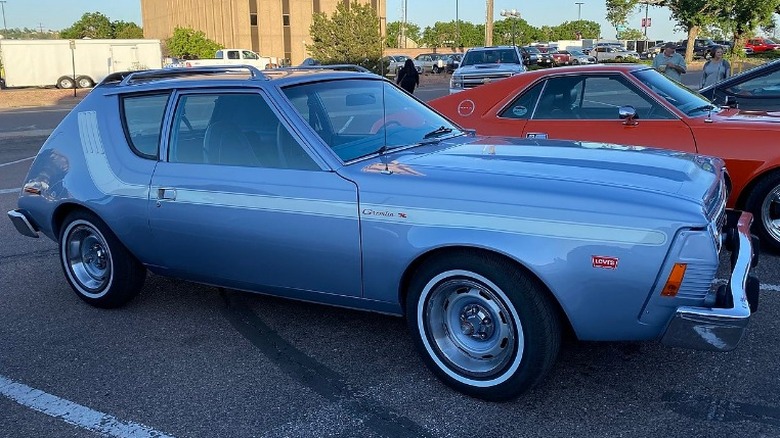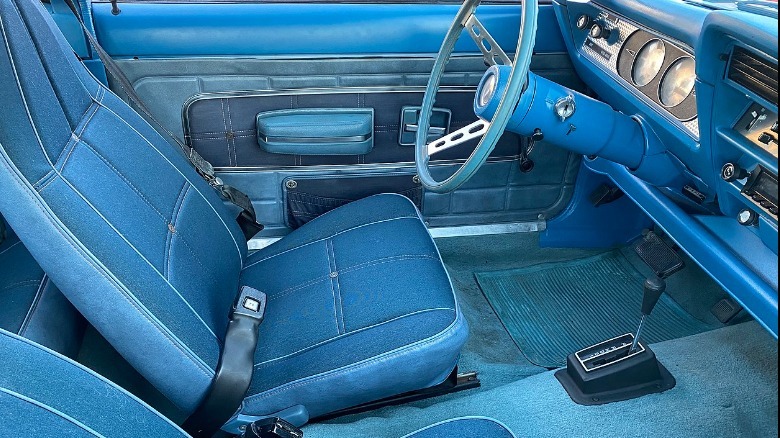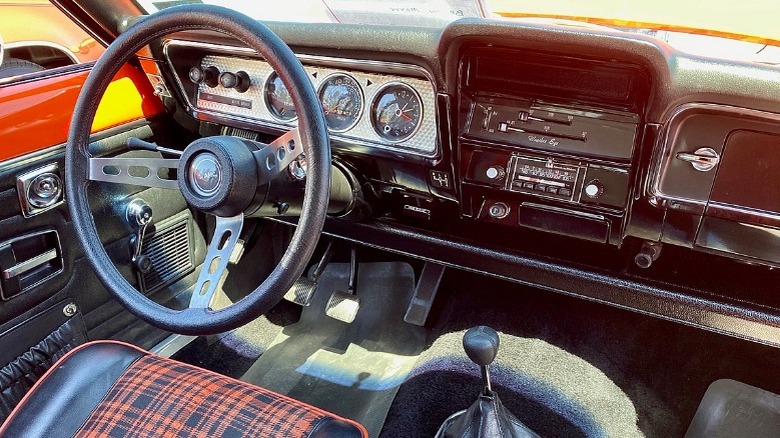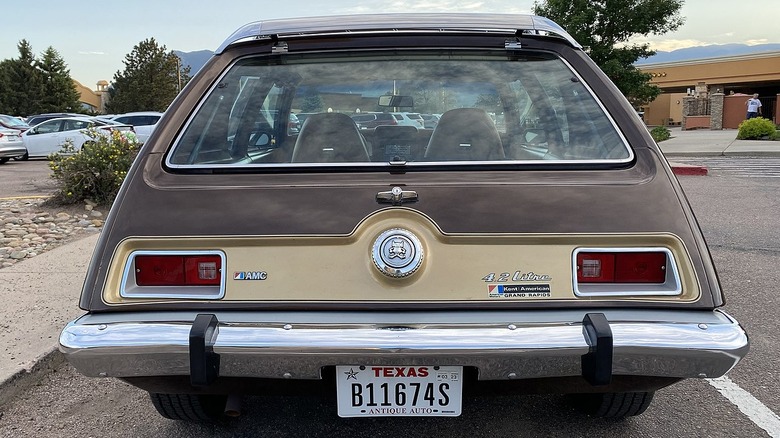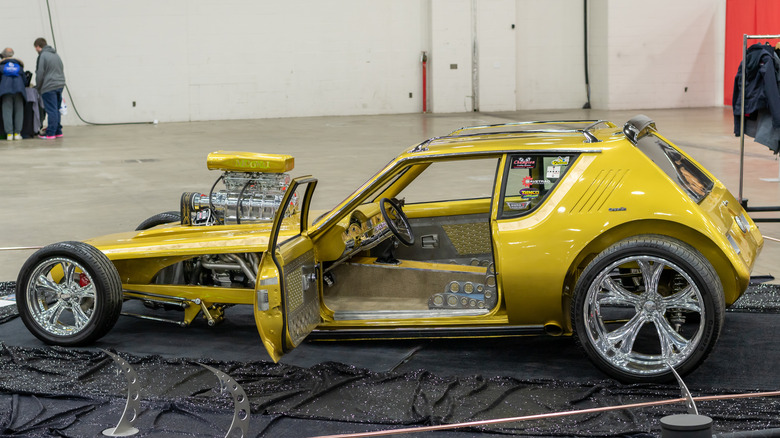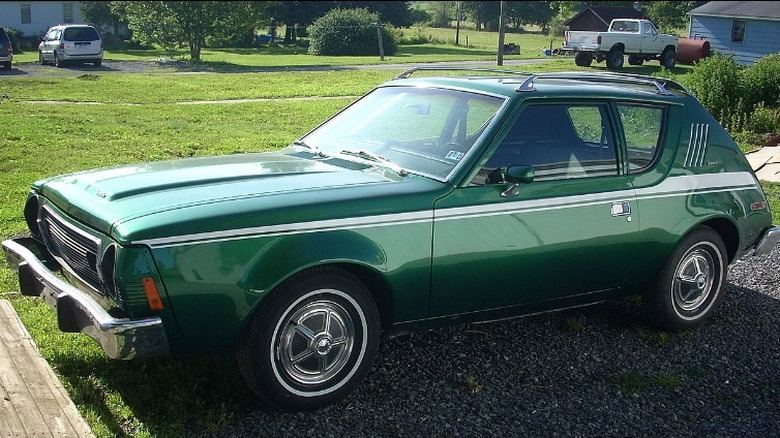Things Only Hardcore Gearheads Know About The AMC Gremlin
The AMC Gremlin is possibly the most oddball car of the late 20th century. To some, it has a face only a mother could love, and, to others, it is endlessly endearing. Regardless of which side of that fence you are on, the car is polarizing. Introduced to showrooms in 1970, the AMC Gremlin came from automaker American Motors Corporation to respond to the demand of American buyers for smaller cars. With its three-door hatchback layout, the Gremlin never aspired to be anything but what it was, a small economy car for an affordable price.
The MSRP of the Volkswagen Type 1 Beetle in 1970 was, according to NADA, $1,839 for the base model, and the base AMC Gremlin was $1,959. By that time, the Beetle had been a small car sales success for around a decade, and American manufacturers needed products to compete with the VW if they wanted to remain competitive. Not only did they not want to give up market share to a foreign company, but they also knew that if you can introduce customers to your entry-level model, the company has a good opportunity of retaining that customer when it is time to upgrade. So the Gremlin got its start at the dawn of the seventies and rolled through the decade to end just before it did, leaving us a quirky little car that continues to be loathed and loved today. Most people know something about these cars, but these are the things only hardcore gearheads know about the AMC Gremlin.
It's 2/3 of an AMC Hornet
AMC is considered an independent automaker as it had no affiliation with a larger corporate entity or parent company. This meant it could be flexible and act fast to make changes, but also that it had to do so with smaller budgets. By the late '60s, its small Rambler American was getting long in the tooth and the all-new AMC-branded Hornet would replace it. The success of the Beetle had been noticed and spurred management to create a competitor based on the Hornet, allowing the company to bring the smaller car to market with a smaller budget than a whole new car model.
AMC Dick Teague is known for creating new models within tight budgetary constraints, presenting the new Gremlin by taking some 12 inches out of the Hornet and shaving the rear to create a kammback hatch, a lesser-used styling element in which the rear of the car slopes downward with an abrupt cutoff. This resulted in a smaller car that offered generous cargo capacity and gave the car a distinctive look (via Ate Up With Motor). AMC had tentative plans for a small version of the Hornet called Wasp, but Teague felt the unusual styling of the Gremlin would draw attention and the kammback design won. The front of the car is nearly identical to the Hornet and it is powered by the same engines while sharing a significant amount of components. However, with only 12 inches fewer, it is honestly more like 9/10 of a Hornet than 2/3, but the difference appears more dramatic.
Sketched on a barf bag
AMC designer Dick Teague is responsible for most of the automaker's AMC AMX most enduring designs, such as the Javelin, AMX, and Jeep Cherokee. Likewise, he was largely responsible for the styling of the Gremlin, along with Bob Nixon as head of the small car studio, according to Hemmings. Nixon oversaw the redesign of the Rambler American before his attention would be placed on the upcoming Hornet. It was during this time when he and Teague discussed the aforementioned small version of the car that never came to fruition and the focus transferred onto what would become the Gremlin.
Working for a large company in the '60s before the invention of all the digital conveniences available to us today made working processes different in unimaginable ways. Communications were slower and hard copies ruled the day. Being physically present was also much more crucial and executive travel was often a large part of the job. This is what led to the Gremlin's unique genesis. Teague had a Northwest Orient flight to pitch the Gremlin to an AMC vice president in the fall of 1966. However, for whatever reason, he was not in possession of Nixon's notes or design sketches to give a visual representation of the new car and proceeded to sketch some preliminary drawings on what he had available, a sick bag from the seat pocket on the airplane.
The business of Gremlins
The benefits of an automobile to business were discovered early in the history of the car, and people began adapting vehicles for business use almost immediately. Aside from producing trucks, not much was done to tailor a car for business needs early on. But that changed as manufacturers developed cars called a Business Coupe. Chatham news explains that in the '30s, two-door cars started being offered with the rear seats removed and in the most stripped-down base model possible to reduce the price to an absolute minimum. These proliferated in the '30s and '40s, offering comfortable transportation for salesmen and company executives who needed to arrive looking sharp. These models fell out of favor by the '50s and mostly disappeared by the end of the decade.
Surprisingly, AMC tried to revive the business coupe in 1970. It can be hard to find much information about this option, but Curbside Classic explains that in its inaugural year, AMC offered a bare-bones base model Gremlin with zero options, no back seat, and a sealed rear window. It was a business coupe for the new era. Having a stripped-down version of a car to save money for business purposes makes some sense, but removing the ability to load cargo through the rear glass makes less sense. According to Hagerty, only 872 buyers opted for the Gremlin business coupe and a lack of buyers the next year led AMC to kill the option. Today, they are the rarest of Gremlin models, but that does not necessarily mean the most desirable.
Was it a joke?
Long before Gremlins referred to what you got from splashing water on a cute and furry woodland creature, it was a mythical being that wreaked havoc on WWII military airplanes. War History Online says that the Gremlin myth likely began during WWI with the first documented use of it in a poem from 1929 but usage became widespread during the terrifying battles of WWII. Starting with the RAF and quickly spreading to the U.S. Army Air Corps.
During the war, instances of problems with aircraft stemming from failures caused by bolts coming loose, linkages breaking, and a long list of other maladies befell pilots and crew fighting the enemy. The intense proliferation of mechanized warfare and rapid mass production of aircraft is the more likely cause, along with inadequate time for pre-flight inspections. But in a time when pilots and soldiers needed to band together to fight effectively, blaming mysterious creatures was much more conducive to morale than pointing fingers at each other.
The AMC Gremlin was released on April 1, 1970, April Fool's Day. But AMC was not kidding. Its new small car was called Gremlin to draw attention and it features a jovial comic-like creature as its mascot. Los Angeles Magazine says that AMC's marketing included the line, "A pal to its friends and an ogre to its enemies." AMC used the name and marketing to attract young buyers who wanted a unique and fun car and would appreciate its quirky styling.
Designer edition by Levi Strauss
In the '70s, high fashion was a big thing and several names had risen to the top and graced the covers of magazines with both their designs and their persona. Another trend was to have designers put their personal touch on a few choice automobiles, resulting in special editions such as a Givenchy Lincoln, Gucci Hornet Sportabout, Pierre Cardin Javelin, and Cartier Lincoln. AMC was a big fan of this kind of tie-in that several models were warmed over by fashion houses. The Gremlin also received such treatment by famed American fashion icon Levi Strauss.
Purveyor of America's best-known contribution to modern fashion, Levi Strauss & Co. offered a generous helping of indigo flair for the economy AMC car. Offered on the Gremlin line from 1973 to 1978, according to Hagerty, the Levi's edition of the Gremlin was advertised as "The car with seats of the pants." Since denim did not adhere to fire safety standards nor would it be able to last as a seat covering, AMC had their supplier produce a material that mimicked the look of denim and adorned the rest of the car in blue like the popular jeans. Levi's logos and included denim pockets on the doors. The Levi's car proved popular enough to keep around for many years, eventually trickling down to AMC's Jeep division, and today, it adds about 20% to the value of well-preserved Gremlins for collectors.
[Featured image by via CAmarlin Wikimedia Commons | Cropped and scaled | CC BY-SA 4.0]
[Featured image by via CZmarlin Wikimedia Commons | Cropped and scaled | CC BY-SA 4.0]
An economy car without the economy
The Gremlin was made to compete with the Volkswagen Beetle. The biggest selling point of the Beetle was the low price, but economy and efficiency were also important, particularly after 1973. The Gremlin initially had an advantage when the debut model came with either a 128 horsepower or 145 horsepower inline-6 (via automobile-catalog) while the 1970 VW had increased output over the years to a whopping 57 horsepower (via How Stuff Works). For only about $100 more, the Gremlin was an attractive choice.
For AMC, sending out a car with an obvious advantage in power delivery seemed like a good business decision, especially since management had no way to foresee a coming oil crisis. But after the crisis hit in 1973, a wimpy 4-cylinder car became a mighty attractive option. The crisis fueled the demand for small cars and it largely contributed to the success of Japanese imports from then until today. Small 4-cylinder car sales skyrocketed and companies that already had them on the lots benefitted, but AMC did not.
Without sufficient budgets to create a new engine, AMC, according to a contemporary New York Times article, turned to competitor VW for a supply of Audi 4-cylinder engines to be adapted for use in the Gremlin. Curbside Classic also notes that this option would increase the price of the car by $253 due to the high cost of importing the engines. For the extra $253 ($1,239 in 2021 dollars), Gremlin owners received only a slight decrease in power with a fuel consumption decrease of 2.5 mpg. Needless to say, it did not sell well, and AMC struck a better deal with the successor model Spirit, which came with the GM "Iron Duke" 4-cylinder.
An unfair reputation
Gremlins are common punchlines in jokes involving cars and they regularly show up on lists of bad cars. They are quirky, odd, and, to some, ugly little cars that never sold in huge numbers of cars like the Pinto. They never had the reliable reputation of Civics or Corollas and many of the design choices were questionable if not downright suspect. But they probably are not as bad as their reputation would have you believe.
AMC was never a sales giant like Chevrolet or Chrysler, but its little Gremlin cars sold extremely well despite the shortcomings of the manufacturer and remained in production for nearly a decade. History is replete with dozens of car models that last only a few years. Motor Trend explains that its quirks stem from being a small car based on a midsize platform, a result of small budgets. It lacked a rear hatch – it only had an opening rear glass – to preserve stiffness and, instead of being built as a subcompact, it was essentially a chopped-up midsize car.
But it sold well. The driving and handling characteristics of the Gremlin are definitely sub-par, but in the '70s, this applied to a lot of cars. The Beetle is no autocross champion and the Pinto drives like a pile of mashed potatoes. Furthermore, while AMC was never known for winning awards for build quality, contemporary Chevy Vegas were suffering from warped cylinder heads and rust while Ford Pintos were reportedly overheating on the highway primarily due to exploding fuel tanks. Gremlins are not so bad after all.
[Featured image by CAmarlin via Wikimedia Commons | Cropped and scaled | CC BY-SA 4.0]
Good tire shredding potential
When Gremlins showed up at dealers in 1970, all of them had a straight-6 engine of either 199 or 232 cubic inch variety. This is the durable engine that eventually became the legendary 4.0-liter used in Jeeps for a couple of decades (via Vicious Offroad). They are full of torque, simple, durable, and reliable. Plenty of aftermarket support exists for the AMC inline-6 due to the expansive community of Jeep fanatics. This gives anyone wanting to set up a Gremlin for performance plenty of upgrades to choose from. However, there might be better ways to accomplish this.
From 1972 through 1976, Gremlins could be optioned with an AMC 304 V8. This was an original 5.0-liter design by the company and it offered decent performance considering the era from which it hails. Because this engine was also used in Jeeps, a large variety of upgrades are available. Furthermore, since there is room for a V8, clever hot rodders can easily adapt another engine, such as the GM LS V8, to fit and make the Gremlin a horsepower monster. Depending on the budget, a Gremlin can easily be turned into an elaborate drag machine or a 12-second custom Gremlin 401-XR with a dealer-installed 401 V8.
First out of the gate
The threat of imports to American automakers in the '60s was genuine and growing. Years before the oil crisis, American tastes were changing and the desire for small cars grew steadily throughout the decade. VW is the best example of how a properly marketed automobile could find success among the increasing size of American cars clogging the highways of the day. As the dawn of the seventies approached, American automakers were all finalizing plans for small cars for the domestic market, except Chrysler, which would rely on Japanese imports until the Omni appeared in 1978.
Since AMC was a smaller company, it was often more nimble and could execute plans faster than the competition. Adding the practice of reusing platforms and spreading development across the brand sped up production as well. Therefore, when the Gremlin debuted on April Fool's Day in 1970, it beat Ford by 6 months, per Jalopnik. Sales may have been a fraction of Ford or Chevrolet, but an independent company like AMC should take a win however it can.
[Featured image by via Graped Ape Wikimedia Commons | Cropped and scaled | CC BY 2.0]
